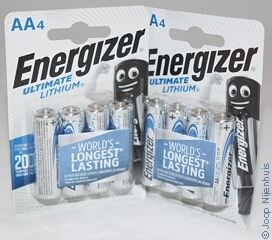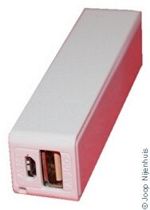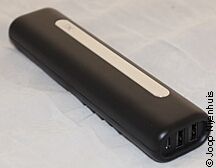Introduction
Almost all current field recorders work also on non-rechargeable (disposable) batteries and no longer only on rechargeable batteries as in the past. The most commonly used batteries are of the AA type in all kinds of chemical compositions. The IEC 60086 system has given this type of cell the designation R6, in the ANSIC18 system this is size 15. The cell of the type AA is a standard sized cylindrical dry battery consisting of a single electrochemical cell that has a disposable battery or can be a rechargeable battery. The exact terminal voltage, capacity and practical discharge rates depend on cell chemistry. The standard clamping voltage of AA cells varies between 1.2V and 1.5V depending on the chemical composition loaded. An AA cell has a length of 49.2 - 50.5 mm, including the button connection and a diameter of 13.5 - 14.5 mm. The positive connection button must have a minimum height of 1 mm and a maximum of 5.5 mm in diameter, the flat negative connection terminal must have a minimum diameter of 7 mm.(*)
Batterijen

|
||
|
Energizer Lithium AA batteries |
||
Non-rechargeable AA-zinc-carbon batteries (dry cells) have a capacity of approximately 400 to 900 mAh (milliampere hours), with the measured capacity strongly dependent on test conditions, duty cycle and switch-off voltage. Zinc-carbon batteries are usually marketed as "standard" batteries. Zinc chloride batteries store around 1000 to 1500 mAh and are often sold as "super" or "extra heavy" batteries. Alkaline batteries with a capacity of 1700 mAh to 2850 mAh are more expensive than zinc chloride batteries, but have a higher capacity.
The non-rechargeable lithium-iron-disulfide batteries are manufactured for devices that consume a lot of power, such as digital cameras and digital recorders, where their high costs are compensated by a longer operating time between battery changes and a more constant voltage during discharging (important for phantom power). Another advantage of lithium-iron-disulphide batteries compared to alkaline batteries is that they do not tend to leak. This is especially important in expensive equipment, where a leaking alkaline battery can cause damage to the point that the equipment needs to be replaced. Lithium-iron-disulphide batteries are intended for use in equipment compatible with alkaline-zinc batteries. Lithium-iron-disulphide batteries can have an open circuit voltage of up to 1.8 volts, but the closed circuit voltage decreases, making this chemistry compatible with equipment intended for zinc-based batteries. A new alkaline-zinc battery can have an open circuit voltage of 1.6 volts, but an iron-disulfide battery with an open circuit voltage lower than 1.7 volts is completely discharged.(*)
Rechargeable cells (batteries)
AA-size rechargeable batteries are available in various chemical compositions: nickel-cadmium (NiCd) in different capacities from approximately 600 mAh to 1000 mAh, nickel-metal hydride (NiMH) in different capacities from 600 mAh to 2750 mAh and lithium-ion. Lithium-ion chemistry has a nominal voltage of 3.6 - 3.7 volts and is called 14500 Li-ion batteries instead of AA. This cell is often also slightly longer than the standard AA cell and therefore does not fit in the battery holder.
The NiMH and lithium-ion AA/14500 cells can deliver most of their capacity even under high current drain (0.5 A and higher), in contrast to alkaline and zinc-chloride ("Heavy Duty"/"Super Heavy Duty" and other fantasy names) cells that have almost no capacity left before these cells are really empty or used up.
Since 2014 a variant of the 14500 Li-ion batteries has been marketed by the Chinese company Kentli as "Kentli PH5". These batteries are supplied with an internal buck converter at the positive electrode to reduce the output voltage from the normal 3.7 V to a very constant (compared to alkaline, NiCd or even NiMH cells) 1.5 V AA- standard voltage. Lithium-ion chemistry causes a lower self-discharge of approximately 3% per month. Unfortunately, the capacity is no better than found with zinc chloride batteries and is approximately 1600 mAh (1.5 V) at a load of 50 mA. This is caused by the low efficiency of the step-down converter.
Nickel-zinc cell (NiZn) AA's are also available, but because they do not occur in the settings of equipment, they are not used (often).(*)
| Chemistry | IEC name | ANSI/NEDA name | Nominal voltage (V) | Capacity with a constant load of 50 mA (mAh) | Max capacity at nominal voltage and 50 mA load (Wh) | Rechargeable |
| Zinc-carbon | R6 | 15D | 1,50 | 400-1.700 | 2,55 | No |
| Alkaline | LR6 | 15A | 1,50 | 1.800-2.850 | 3,90 | No |
| Li-FeS2 (Lithium) | FR6 (LR6?) | 15LF | 1,50 | 2.700-3.400 | 5,10 | No |
| Li-ion | R15/50 | 14500 | 3,60-3,70 | 600-840 (1600 mAh at 1,5V) |
2,88-2,96 | Yes |
| NiCd | KR6 | 15K | 1,20 | 600-1.000 | 1,20 | Yes |
| NiMH | HR6 | 15H | 1,20 | 600-2.750 | 3,42 | Yes |
| NiZn | ZR6 | ? | 1,60-1,65 | 1.500-1.800 | 2,97 | Yes |
NiMH battery
The nickel-metal hydride battery, abbreviated NiMH battery, is a rechargeable nickel-based battery and a metal hydride that resembles the nickel-hydrogen battery. The NiMH battery uses a hydrogen-absorbing alloy for the negative electrode instead of cadmium. As in NiCd cells, the positive electrode is nickel-oxyhydroxide (NiOOH). A NiMH cell can often store more energy than a NiCd battery but has less power with the same dimensions. Compared with the lithium-ion battery, the energy density is lower and the self-discharge is higher. NiMH cells are marketed in standard sizes (mini penlite AAA and penlite AA to F). They are also assembled into higher voltage batteries such as in hybrid cars, RC cars, cordless phones, etc.
Standard AA cells (penlite) have a nominal capacity (C) of 1100 mAh to 2900 mAh at 1.2 volts, measured at a discharge of 0.2 C per hour. At higher loads, more energy is lost, but up to 1C (full discharge in one hour) that saves little.
NiMH batteries suffer less from the memory effect as with NiCd batteries. However, NiMH batteries cannot withstand low and high temperatures. At low temperatures the battery loses its charge and at high temperatures the battery is damaged. At what temperature that happens depends strongly on the brand and quality. Even under normal circumstances, a normally constructed NiMH battery has a fairly large self-discharge, making them less suitable for applications where it must also be possible to supply energy after a longer period of time. Special constructions can considerably reduce the self-discharge, but this is at the expense of capacity. Such batteries are also called "Low Self Discharge" (LSD) or "Ready to Use".
With normal use, the NiMH battery lasts shorter than a NiCd battery. An (environmental) advantage over NiCd is that no (toxic) cadmium is used.(*)
Lithium battery
A lithium battery is a battery whose anode consists of metallic lithium. Manganese (IV) oxide is often used for the cathode, but there are many other options. Depending on the cathode material, a lithium battery can supply a voltage of 1.5 to 3.7 volts.
Lithium batteries are relatively expensive, but will last for a very long time if they are not discharged. Depending on the type up to decades. They are used in the form of a button cell in watches, remote controls and computers; and in other forms, for example, in pacemakers and military equipment. The commonly used CR 2032 button cell is a lithium battery. According to the IEC nomenclature for batteries, all types of which the first letter is a B, C, E, F or G are lithium batteries. The different letters indicate different classes of cathode materials, for example the C for manganese (IV)-oxide and B for carbon-monofluoride. In contrast to lithium-ion, lithium-ion-polymer, lithium-iron-phosphate and lithium-sulfur batteries are lithium batteries not rechargeable.(*)

|
||
| Xtorm power bank connected to recorder via USB | ||
A test was carried out with 21 AA batteries and this test can be seen here. This test is written in Dutch language.
Powerbank
Powerbank is an English term for as much as a battery with some additions. A power bank contains a battery and the necessary electronics for charging and discharging. The electronics ensure that the battery is not overcharged, the charging currents do not become too high, and on discharge that the discharging current is regulated and that the voltage is regulated. In principle, a power bank is a reliable source of energy. Yes, but it's in capacity. The additions 1x, 4x, 8x and so on refer to how many standard sets of AA batteries it can replace. So an addition of 1x means so much that you have an extra set of AA batteries with you. For 4x this means four times a set of AA batteries. The set of AA batteries must of course be able to provide a minimum of 5 Volts, so that is then 4 AA batteries. The capacity of such a set is around 2,200 mA to 2,500 mA (eg Duracell). Power banks generally come with a short USB cable. On one side you can charge the power bank and on the other side you can discharge the power bank and thus feed a device.

|
||
| Powerbank 1x | ||
Examples of a power bank
Power Mate is a powerbank type large key ring, capacity 2,200mAh. Output voltage DC5V (DC is direct voltage) with a maximum current of 1A. Including USB cable with micro USB plug. This power bank is often used as a promotional gift or promotional item with a printed text. And that's how I got it.

|
||
| Xtorm Power Bank 4x | ||
(*) part of the information has been obtained from Dutch and English Wiki pages on this subject.
revision July 30, 2020